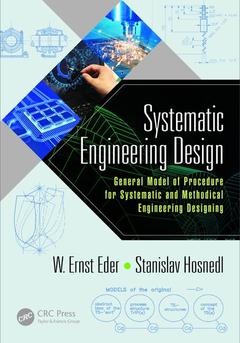Systematic Engineering Design General Model of Procedures for Systematic and Methodical Engineering Designing
Auteur : Hosnedl Stanislav

This book is developed as a scientific observation and description of all generalized engineering systems, in terms of what is needed to characterize them and in turn what must be considered in designing them. Chapters 1- 4 provide an extensive outline (and theory) of what all technical systems have in common, and what design considerations make these technical systems suitable for use within industry and within daily life. These concepts are appropriate for students of any branch of engineering. Chapters 5 - 8 translate the insights of the preceding chapters into suggested approaches to the systematic design of systems. Problem solving techniques and open ended problems are introduced.
Introduction. Story of Robinson Crusoe.Context of Design Engineering in Society. Theory B Subject B. Transformation. Generalization and Entry to Terminology. Model of the Transformation System. TrfP Properties. Extension of TrfS Model. Technical Processes. Human Needs and their Satisfaction. Basic Knowledge for Realizing Technical Processes. Trends in Development of Technical Processes. The Applied Technology. Classes of Operators of Technical Processes. Assisting and Secondary Inputs, and Secondary Outputs of Technical Processes. Structure of Technical Processes. Operations Transformed in Technical Processes. Types of Process. General Model of Technical Processes. Synopsis of Statements about Technical Processess. Technical Systems (TS) B Objects. Purpose and Tasks of Technical Systems. Mode of Action of Technical Systems B How They Work. Properties 3 of Technical Systems. Quality of Technical Systems. Relationships Between Properties. Knowledge about Properties B Designers=Technical Knowledge. Structures of Technical Systems. Constructional Structure. Organ Structure. Function Structure. Recapitulation. Assisting and Secondary Inputs, and Secondary Outputs, Disturbances. Phases of Origination and Existence of Technical Systems. Development in Time of Technical Systems. Taxonomy of Technical Systems. Knowledge about Special Kinds of Technical Systems B Families. Extension of TS-Life Cycle Model. Synopsis of Statements about Technical Systems. Engineering Design Processes. Aim (Goal) of the Engineering Design Process. Purpose of the Design Process B Operand of Designing. Terminology B Design, Designing, Design Process.Design Research. Model of the Design Process. Structure of the Design Process. Hierarchical Arrangement of Design Operations. Procdurally Logical Arrangement of Design Operations. Procedure in Designing. Conditions for a General Design Procedure. Basis of Knowledge for Systematic Design. Design Strategy: Models of Procedure. Fitting the General Model to Particular Condition. Design Tactics: Methods and Working Principles. Operators of the Design Process. Operator B Engineering Designers. Operator B Working Means in the Design Process. Operator B Information System, Domain adn Branch Knowledge. Operator B Active and Reactive Environment. Survey of Some Applicable General Methods to Assist Designing. Synopsis of Design Process Statements. The General Model of Procedure for Systematic adn Methodical Designing. Requirements for the Model Procedure. Conceptual Basis of the Model. Elaborating the Assigned Problem, Clarify the Design Specification. Conceptual Design B Conceptualizing. Laying Out B Embodying. Detailing B Elaborating. Re-design Procedure. Part B. B Problem Solving B Property-Driven Designing. Generalized Basic Operations in the Engineering Design Process. Stating the Problem. Searching for Solutions. Evaluating and Deciding.Selection of Criteria for the Evaluation. Choice of Scales for the Criteria. Determinations of Values for the Criteria. Processing of the Individual Values into a Total. Providing and Preparing Information. Properties fo Technical Information. State of the Information. Classification System for Information. Working with Information. Verifying/Checking. Representing. Interative Procedure. Design Situations. Case Studies. Case Example 1: Life-Boat Divits. Task Defining. Conceptualizing. Embodying/Laying-Out and Detailing. Sub-Problem B Transmit
Ernest Eder was born in Vienna, Austria and has been involved in industrial design and instruction over the past 40 years. He has taught engineering design at the University College of Swansea, the University of Wales, the University of Calgary, Loughborough University and lastly the Royal Military College of Canada.
Professor Stanislav Hosnedi is a full professor at the University of West Bohemia in the Czech Republic. He has been involved with engineering design instruction over the past 30 years and has written a large number of papers and published books on design. He was honored with the Fred Merryfield Design Award in 1990.
15.6x23.4 cm



